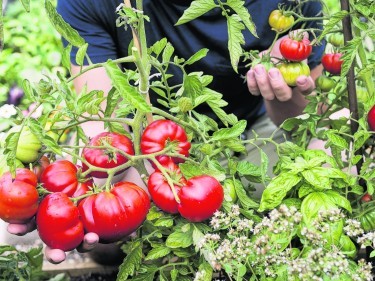Self-confessed botany geek and TV gardening expert James Wong offers Hannah Stephenson some unusual tips and tricks on how to improve the flavour of your home-grown harvests
It’s all very well joining the “grow your own” brigade – but what if your tomatoes don’t taste sweet, your beans are stringy and your chillis lack punch?
Before you head back to the vegetable racks at the supermarket, take some advice from TV gardening expert James Wong, who has just written RHS Grow For Flavour, with tricks to make your crops tastier.
This ebullient botanist and broadcaster tells me that if we water our crops too much they’ll lack flavour, that trying alternative compost mixes may help us taste the difference and not all crops taste better when just harvested.
The Kew-trained “plant geek”, who is ambassador for Fiskars and has a Homegrown Revolution range with Suttons Seeds, is hoping to put the va va boom back into flavour.
“The things you aim to do for fruit may be the opposite of what you want to do for some vegetables.
“In general, the less you water and the less you fertilise and the sunnier the spot, the better your crops will taste.”
He rejects claims that heirloom varieties always taste better, and dispels myths that you should always defoliate leaves on tomato plants to ripen their fruit.
He also challenges some traditional methods, advising us to pick broad beans when tender and eat them like mangetout, and to use a dilute of molasses to boost crops grown in the ground.
This, along with advice on giving your lettuce seedlings a daily stroke to improve their establishment by up to 70%, and spritzing tomato plants with aspirin solution, will make some traditionalists baulk, but he backs it up with a lot of scientific evidence.
Tomatoes happen to be a bugbear of mine. Every year I grow them, and every year they get late blight. Wong admits he was in the same boat but he’s finally cracked it.
“Firstly, there are some varieties that are much more tolerant (he cites ‘Crimson Crush’ as an example), but another solution is one-truss training (pinching out the top of the plants after they have set their first truss of fruit, turning them into dwarf plants). This works because the fruit are produced so much earlier in the year so are harvested before late blight occurs.
“Per plant, you end up with one instead of four trusses, but per square
metre of beds you get exactly the same yield. The fruit from one-truss training are bigger, sweeter, contain more anti-oxidants and are a better colour.”
He has read thousands of scientific papers to support his theories as well as growing and trying the produce himself.
But he’d avoid growing vegetables which he feels are not worth the time, money or flavour difference compared with supermarket varieties.
“Some crops will taste measurably better if you grow them yourself, such as tomato, strawberries and sweetcorn.
“Crops which would taste much the same as the supermarket include celery, most onions and potatoes.”
RHS Grow For Flavour by James Wong is published by Mitchell Beazley, priced £20 (www.octopusbooks.co.uk). Available now.

